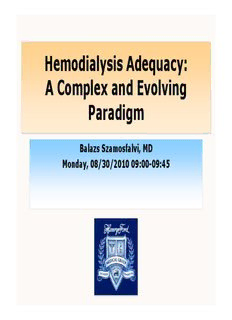
Hemodialysis Adequacy: A Complex and Evolving Paradigm PDF
Preview Hemodialysis Adequacy: A Complex and Evolving Paradigm
Hemodialysis Adequacy: A Complex and Evolving Paradigm Balazs Szamosfalvi, MD Monday, 08/30/2010 09:00-09:45 Adequacy 1943 - 1970 • The patient survived the dialysis session • Uremia improved • Volume status improved • Patient survival to ©Fresenius ©Freserneiusc overy of kidney function or transplant Source: http://www.homedialysis.org/learn/museum/ Adequacy 1970 - 2000 • Safe dialysis sessions in large numbers • Good control of uremia • Focus on small solute (urea) kinetics • Volumetric ultrafiltration • Patient survival on ©Fresenius ©Fresenius dialysis for years • Large clinical studies and guideline development Source: http://www.homedialysis.org/learn/museum/ AAAdddeeeqqquuuaaacccyyy 222000000000 →→→ IIInnntttooo ttthhheee FFFuuutttuuurrreee Adequacy of Dialysis Better biocompatibility: Daily and or long (nocturnal) Improved membranes and dialysis for BP and Ca x P control ultrapure dialysate Middle molecule removal: Hemo- Blood volume monitoring for diafiltration and internal filtration safer ultrafiltration Computer-aided HD design and Reduced clotting and monitoring (Online clearance) inflammation: Automated regional citrate anticoagulation FOCUS ON COST-CONTROL OUTCOME: Quality of Life & Rehabilitation Reduced Morbidity & Mortality HD Adequacy 1. The uremic syndrome and uremic toxins • Uremic toxin removal • Volume homeostasis 2. Kinetic studies of solute movement • Solute flux studies on the dialyzer • Online dialyzer flux measurements and computer modeling • Solute flux studies in the patient • Computer modeling of patient solute fluxes and levels 3. New directions after the HEMO and MPO studies • HEMO and MPO interventions failed to improve outcomes • Quality control: online clearance, computerized data collection • Renewed interest in home dialysis: HD duration, frequency • New technology: internal filtration, bio-feedback systems, citrate anticoagulation Uremic toxins I. Small (< 500 D); water soluble (cid:131) Surrogate marker urea or sodium (ionic dialysance) (cid:131) Rapidly produced in intracellular fluid compartment (cid:131) Large variability in intra-patient kinetics (e.g. phosphate) II. Middle-molecules (500 – 40,000 D); water soluble (cid:131) Β2-microglobulin, PTH, some cytokines (IL-6, TNF) (cid:131) Optimized filter design and convection for removal (cid:131) Complex intra-patient kinetics (generation, compartments) III.Small (< 500 D); protein-bound (cid:131) Poorly removed with traditional dialysis (cid:131) Resin adsorption-based therapies are in development Vanholder et al:Review on uremic toxins; Kidney International, Vol. 63 (2003), pp. 1934–1943 Vanholder et al:A bench to bedside view of uremic toxins; J Am Soc Nephrol 19: 863–870, 2008. European Uremic Toxin Work Group (Eutox; http://EUTox.info) EEExxxaaammmpppllleeesss ooofff UUUrrreeemmmiiiccc TTToooxxxiiinnnsss From Primer On Kidney Diseases, 2nd edition Solute fluxes on the dialyzer 1. Nomenclature • Clearance and dialysance • Efficiency and flux (membrane area and pore size) • Diffusion and or convection (plus adsorption) 2. Analytical mathematical models and solutions • Concept of K A and the classic diffusive clearance equation 0 • Limitations of K A: effect of internal filtration and shunting 0 • Bio-fouling: albumin coating, progressive blood clotting 3. Computer models and online measurements • More precise modeling of mathematically complex treatments • Online, multiple measurements of delivered ionic dialysance (precise surrogate for effective urea clearance) Depner T and Garred L: Solute transport mechanisms in dialysis; in Replacement of Renal Function by Dialysis, 5th edition; p73-93 Nomenclature 1. Dialysance and Clearance • The volume of blood cleared from the concentration difference of a solute between the fresh blood and the fresh dialysis fluid entering the filter • Clearance: special case of dialysance when the fresh dialysate solute concentration is zero 2. Efficiency and Flux • Efficiency: ability to achieve large small solute clearance with high blood flows (all filters are high efficiency these days) • Flux: ability to achieve high middle molecule clearance and ultrafiltration rate (determined by the average pore size) 3. Diffusion and Convection • Diffusion: solutes move by diffusion between blocks of fluid separated by the membrane • Convection: solutes move en mass with a block of fluid across the membrane (more effective for moving large molecules) MMeemmbbrraannee FFlluuxx aanndd PPoorree SSiizzee ((11)) Sivasankaran Ambalavanan, Gary Rabetoy & Alfred K. Cheung; www.kidneyatlas.org
Description: